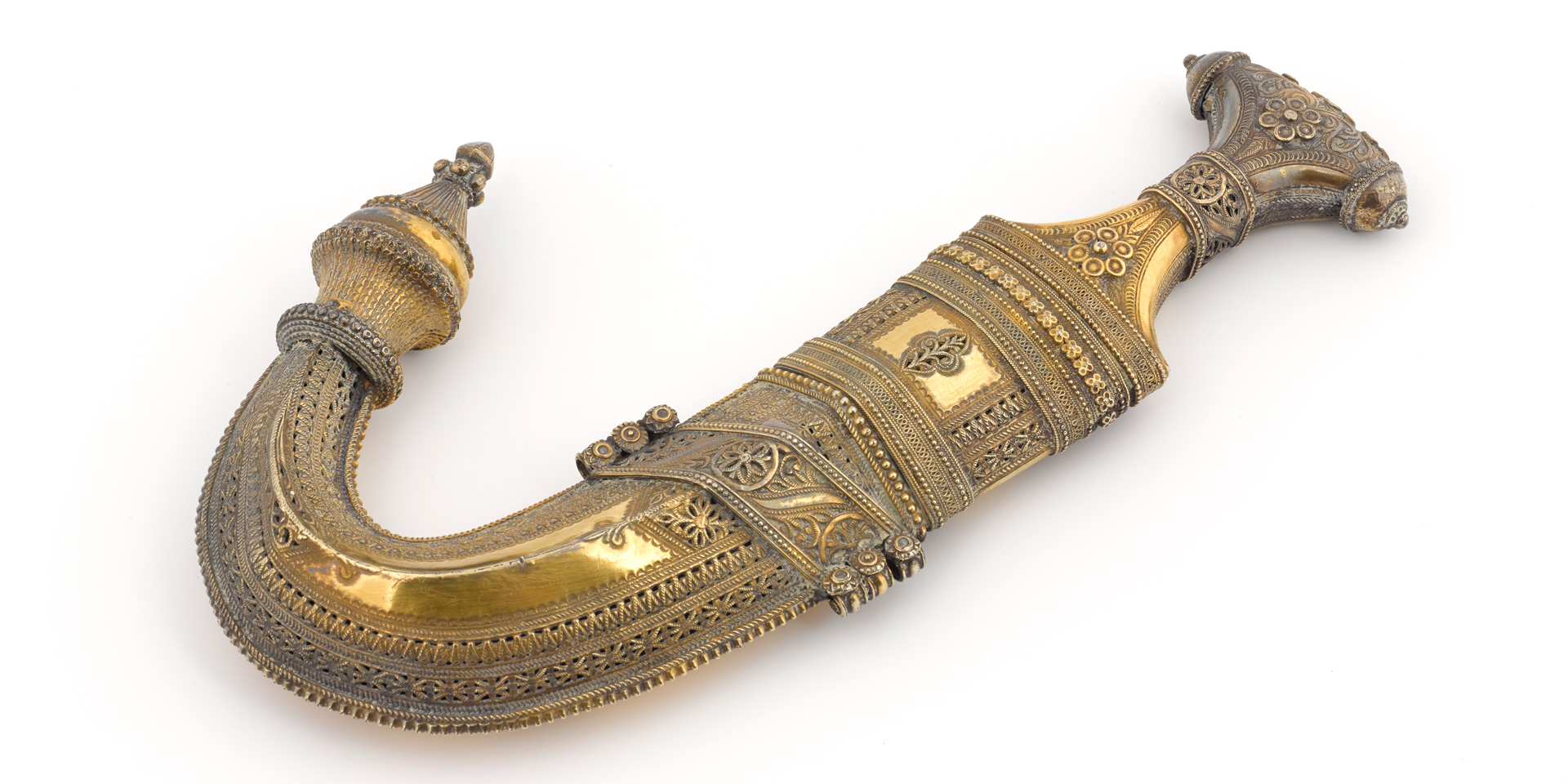Lawrence of Arabia’s dagger, robes and kaffiyah saved for the nation

Lawrence of Arabia's dagger
The National Army Museum has saved TE Lawrence’s dagger, robes and kaffiyah for the nation thanks to two grants from the National Heritage Memorial Fund (NHMF) totalling £113,400.
Lawrence was given the dagger, known as a jambiya, by Sherif Nasir in 1917 after the victory of the Arabs at Aqaba in modern day Jordan. It had been sold to an overseas buyer in 2015, but an export licence bar was made on the recommendation of the Reviewing Committee on the Export of Works of Art earlier this year. The dagger was secured by the National Army Museum with a £78,400 grant from the NHMF.
Few British soldiers have a greater legend attached to them than TE Lawrence, also known as Lawrence of Arabia. While his military and diplomatic efforts attracted some distinction, it is Lawrence’s immense cultural impact in the century since his wartime achievements that has resulted in the most attention.
Lawrence’s military exploits are well documented. His approach to working with the Arab tribes, of full integration and the abandonment of British dress, delivered great success. Wearing a jambiya was customary for men at the time and would have helped Lawrence further ingratiate himself with his Arab allies. It helped complete his transition from the khaki-clad British soldier to Arab leader.
As impressive as his military feats were, the image of Lawrence wearing the robes and dagger was one that he and others cultivated to greatly further his reputation and seal his legend in popular culture. In all his representations, both documentary and fictionalised, Lawrence’s preference for Arab dress feature centrally to the legend, enigma and representation of Lawrence and all that he achieved.
The robes are intrinsically linked to Lawrence and a vital part of his mystique. Designed to be a lightweight ensemble, perfect for the desert environment, Lawrence himself said: ‘If you can wear Arab kit when with the tribes, you will acquire their trust and intimacy to a degree impossible in uniform.’
The robe was one of two given to the mother of Arthur Russell, who enrolled in the Tank Corps with Lawrence. Lawrence told her to cut them up and make dresses out of them but luckily Russell managed to save this one from her scissors. The kaffiyah was given to the artist Cosmo Clark by Lawrence after he sat for a portrait in 1922. Clark was one of the illustrators for Lawrence’s book, The Seven Pillars of Wisdom and Revolt in the Desert. Both items were acquired thanks to a further NHMF grant of £35,000.
The depiction of Lawrence’s role in the history of the First World War in the Middle East through films and portraits made Lawrence a media star, a prototype for the cult of celebrity that we see so strongly in modern Western media. But it also ensured a far greater recognition for a theatre of conflict in the Great War beyond the Western Front in France and Belgium. The legacy of Britain’s role in reshaping the Middle East in the aftermath of the collapse of the Ottoman Empire, to which Lawrence was a direct observer, continues to affect us today and influence the world around us.
Minister of State for Digital and Culture Matt Hancock said:
'The image of TE Lawrence with his dagger is one of the most iconic of the 20th Century. It's fantastic news that thanks to the export bar process this extraordinary piece will now be on display along with his robes and kaffiyah at the National Army Museum for all of the public to enjoy.'
Sir Peter Luff, Chair of National Heritage Memorial Fund, said:
'TE Lawrence was a remarkable man and is an enduring figure in popular culture. These items are a vital part of his wartime identity which should not be lost to the nation. That is why the National Heritage Memorial Fund decided to step in to help the National Army Museum to buy them.'
'I am sure that visitors to the museum, will be fascinated to see the dagger, robes and kaffiyah and I hope many of them will be inspired to find out more about Lawrence and the often forgotten campaign waged by Britain and her allies in the deserts of the Middle East during the First World War.'
Dr Peter Johnston, Head of Collections Development and Review at the National Army Museum, said:
'Lawrence is an iconic figure in the history of the First World War and the Middle East. While the Middle East theatre is often forgotten in the popular memory of the conflict, the actions there have had enormous ramifications for the past 100 years.'
'What makes the dagger and robes so significant, and such an important part of British heritage, is the way in which they have featured in the cultural memory and legacy of Lawrence and the Middle East campaign of the First World War. The dagger and the robes even became important narrative features at the heart of David Lean’s epic film Lawrence of Arabia, which has shaped and dictated how we in modem Britain, and elsewhere in the world, think of Lawrence of Arabia and Britain’s role in shaping the region.'
Notes for editors
For more information, please contact the National Army Museum press office at pr@nam.ac.uk or 020 7881 2433.
National Army Museum
The National Army Museum is the leading authority on the history of the British Army. Founded in 1960 by Royal Charter and established for the purpose of collecting, preserving and exhibiting objects and records relating to the Land Forces of the British Crown it is a museum that moves, inspires, challenges, educates and entertains.
The Museum tells the story of the British Army, the personal experiences of the soldiers who have served and connects the British public and its Army demonstrating how the role of the Army and its actions are still relevant today.
National Heritage Memorial Fund (NHMF)
The National Heritage Memorial Fund was set up in 1980 to save the most outstanding parts of our national heritage, in memory of those who have given their lives for the UK. It is receiving £20million Government grant in aid between 2011-15 allowing for an annual budget of £4-5m.
These items join a diverse range of over 1,200 iconic objects and places which have been safeguarded by the NHMF to the tune of over £300million. These include:
- The Coenwulf Coin
- The Mary Rose
- The Flying Scotsman
- The last surviving Second World War destroyer, HMS Cavalier
- A collection of the work of Second World War code-breaker Alan Turing
- The personal archive of Siegfried Sasson, First World War soldier, author and poet
- Skokholm Island, Site of Special Scientific Interest (SSSI) in Pembrokeshire
Natasha Ley, NHMF Press Office, 020 7591 6143 or out of hours 07973 613820 Email: natashaL@hlf.org.uk

